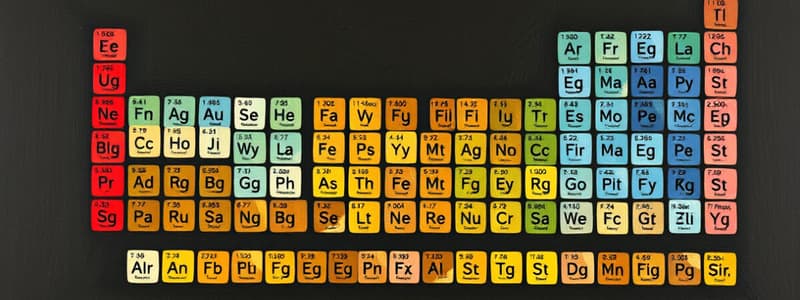Podcast
Questions and Answers
How did chemists begin to organize the known elements?
How did chemists begin to organize the known elements?
Chemists used the properties of elements to sort them into groups.
How did Mendeleev organize his periodic table?
How did Mendeleev organize his periodic table?
Mendeleev arranged the elements in his periodic table in order of increasing atomic mass.
How is the modern periodic table organized?
How is the modern periodic table organized?
In the modern periodic table, elements are arranged in order of increasing atomic number.
What are three broad classes of elements?
What are three broad classes of elements?
What is periodic law?
What is periodic law?
What are metals?
What are metals?
What are nonmetals?
What are nonmetals?
What are metalloids?
What are metalloids?
Explain how chemists began the process of organizing elements.
Explain how chemists began the process of organizing elements.
What property did Mendeleev use to organize his periodic table?
What property did Mendeleev use to organize his periodic table?
How are elements arranged in the modern periodic table?
How are elements arranged in the modern periodic table?
Name the three broad classes of elements.
Name the three broad classes of elements.
Identify each element as a metal, a metalloid, or a nonmetal. Element A: ___, Element B: ___, Element C: ___, Element D: ___
Identify each element as a metal, a metalloid, or a nonmetal. Element A: ___, Element B: ___, Element C: ___, Element D: ___
Which of the following sets of elements have similar physical and chemical properties?
Which of the following sets of elements have similar physical and chemical properties?
Name two elements that have properties similar to those of the element sodium.
Name two elements that have properties similar to those of the element sodium.
Flashcards are hidden until you start studying
Study Notes
Introduction to Organizing Elements
- Early chemists sorted elements based on their physical and chemical properties.
- This classification laid the groundwork for more systematic arrangements of elements.
Mendeleev's Periodic Table
- Mendeleev organized elements by increasing atomic mass.
- His periodic table demonstrated that elements with similar properties occurred at regular intervals.
- He predicted the existence of undiscovered elements, leaving gaps for them in his table.
Modern Periodic Table
- The modern periodic table arranges elements by increasing atomic number (number of protons).
- Elements are grouped into rows (periods) and columns (groups) based on similar characteristics.
- The periodic law states that properties of elements repeat periodically when ordered by atomic number.
Classification of Elements
- Elements are broadly classified into three categories:
- Metals: Good conductors of heat and electricity, typically shiny with high density.
- Nonmetals: Poor conductors, have opposite properties of metals, often dull and brittle.
- Metalloids: Exhibit properties intermediate between metals and nonmetals, useful as semiconductors.
Properties of Metals and Nonmetals
- Metals are characterized by high luster and the ability to conduct heat and electricity effectively.
- Nonmetals are typically insulators and tend to be more reactive with other elements.
Key Comparisons and Classifications
- Chemists utilized physical and chemical properties to group elements effectively.
- Each group in the periodic table features elements with similar physical and chemical properties.
- Examples of elements with similar properties to sodium include lithium, potassium, rubidium, cesium, and francium.
Summary
- Understanding the organization of elements provides insights into their behavior and interactions.
- The transition from Mendeleev's organization based on atomic mass to the modern arrangement by atomic number marked a significant advancement in chemistry.
Studying That Suits You
Use AI to generate personalized quizzes and flashcards to suit your learning preferences.




